Hernán Cortés: Conqueror of the Aztecs
Hernán Cortés was a 16th-Century Spanish conquistador who is most well-known for his conquest of the Aztec Empire. 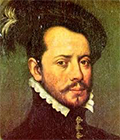
He was born in 1485 in Medellín, in Extremadura, a province of Castile. At the time, the ruling monarch was Isabela I, who was married to Ferdinand II of Aragon; the two ruled jointly over most (and then all) of what is now Spain. Hernÿn's parents were Martím Cortés de Monroy and Doña Catalina Pizarro Altamarino; they were nobles of some note. The boy suffered from ill health but was nonetheless a good student. When he was 14, he gained admittance to the University of Salamanca, ostensibly to study law, but did not last long, dropping out after two years of study. He found the promise of gold and weath much more appealing, for by the time he was a teenager, the Italian explorer Christopher Columbus had returned from the New World and ushered a wave of Spanish exploration there. Following in Columbus's footsteps, Cortés in 1504 sailed to Hispaniola, the governor of which was a family friend. Cortés used his education and family connections (his father had served in the military) to get a job as a notary, in the town of Azúa. He also found his way into owning a farm and gained wealthy in the process. 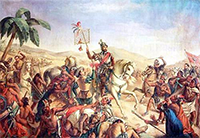
In the New World, his health improved and he underwent military training himself. He soon came to the notice of the colonial administrator Diego Velázquez, who chose Cortés to accompany him on an expedition to conquer the island of Cuba. The resulting conquest, in 1511, was brutal yet efficient, resulting in massacres of civilians and the public execution of a native chieftain. Named to lead the new city of Santiago was Cortés. Francisco Hernández de Córdoba was the first European known to visit the Aztec civilization. He and a force of 100 Spaniards arrived, from Cuba, in 1517. After a brief tour of the area, he returned and convinced the governor there, Diego Velásquez, to send a larger force. After another expedition the following year, led by Juan de Grijalva, Spain agreed on a larger mission; this time, the leader was Cortés. He and a few hundred men arrived in 1519 at the head of a force of a few hundred soldiers. Their mission was to established contact and, if possible, trade with people living in Mesoamerica. 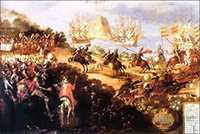
Cortés landed on what is now the southeastern coast of Mexico. He and his men founded a settlement that would become the city of Veracruz. Cortés, at one point getting wind of the desire of many of his men to return to Cuba, ordered the ships scuttled, stranding the Spanish force on land. After a period of intense training, Cortés and 400 soldiers marched into Aztec territory and found a willing ally in Tlaxcala, a neighboring city-state then at war with the Aztecs. Along the way, Cortés made friends with other city-states wishing to throw off the Aztec yoke, including Cempoala and Huejotzingo. Helping facilitate all of this alliance-making was an enslaved woman who could speak multiple languages. She was known to her people as La Malinche; the Spaniards called her Doña Marina. 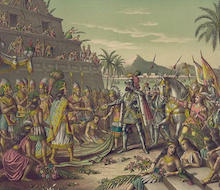
Cortés and his invaders arrived in Tenochtitlan, the Aztec capital, in November 1519. Moctezuma, the Aztec supreme ruler, welcomed Cortés as a friend, not the least because the light-skinned Spaniard bore more than a passing resemblance to the god Quetzalcoatl, whom legend said would return. The two leaders met officially on November 8. In a series of meetings, Cortés and his men caught glimpses of a treasure room filled with gold. This put many of them in mind of conquest. Cortés eventually gained the upper hand, convincing Moctezuma that the Spaniards' weapons more than made up for their deficit in number of warriors. Cortés and his men took Moctezuma and a number of other nobles hostage, and the Spaniards gained control of the capital city. Turning their guns and other weapons on the natives, Cortés and his men killed Moctezuma and thousands of others, beginning the Spanish conquest of the Aztec Empire. The resistance formed almost immediately, as Cuauhtemoc, a nephew of Moctezuma, took over as ruler, rallied the troops, and forced the Spaniards to retreat. Cortés went back to the alliance with Tlaxcala and returned at the head of a large joint invasion force. He didn't return right away. In between his appearances, a suite of European diseases that he and his men had brought with them wreaked havoc on the Aztecs, helpless against measles, mumps, and smallpox–none of which had appeared in that part of the world before. Some estimates are that in just the year 1520, imported diseases killed 40 percent of the population. In that same year, Cortés was busy fighting off an insurgency within his own ranks. The Cuban governor, Velázquez, had restricted Cortés's mission to exploration and trade because the governor himself wanted to be the conquistador who took over the mainland. In April 1520, Velázquez send a large number of Spanish troops under the command of Páfilo de Narváez to wrest command from Cortés and 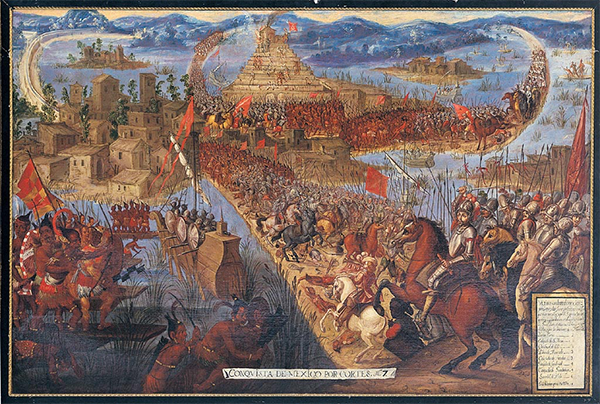 Cortés returned in May 1521. This time, he was aiming at conquest. On Aug. 13, 1521, Cuauhtemoc surrendered and the Spanish victory was complete. To cement his dominance, Cortés ordered another round of mass executions and then ordered Tenochtitlan burned to the ground. On its ashes he ordered built Mexico City. Any Aztecs who survived fled to nearby Tlatelolco. The Spanish rule began. Cortés named the area New Spain and Mexico City its capital. King Charles I appointed Corés Governor of New Spain. Under his leadership, the city grew in influence and power, its representatives fanning out across Mesoamerica to establish relations with neighboring city-states. He proved far-thinking in one regard, setting up the encomienda system, a remnant of the feudal system in which Spanish nobles got the right to a certain number of native people who would provide labor as a means of maintaining the conqueror-conquered relationship. The conquered, in this case, also had to tribute, or taxes; and since money was in short supply, that tribute took several forms, among them animal food, various crops, and even raw metals. In return, the encomendero, or leader, would guarantee protection against attack. The Spanish Crown encouraged such enterprises, insisting that that protection also take the form of learning the Spanish language and the Christian faith. Before he had left Cuba, Cortés had married Catalina Suarez, sister of a friend. She stayed behind while her husband was off conquering; the two were reunited in New Spain in 1522. She died not long after she arrived. 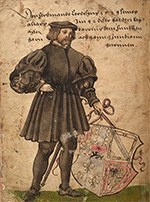
He was not the most popular of leaders and, in 1528, went back to Spain, to try to reverse that trend. (He had traveled to what is now Honduras in order to put down a revolt there and, when he returned to the capital, found himself removed from power.) What he received was mixed. On the one hand, the Crown gave him a title, Marquis of the Oaxaca Valley; however, the Crown also removed Cortés from his position as governor of New Spain. It was at this time that he married again, to Juana de Zúñiga; they had three children together. He wasn't done with the New World, leading an expedition to explore Baja California in the 1530s. (As it happened, another explorer, Francisco de Ulloa, named the nearby body of water the Sea of Cortés; this later became the Gulf of California.) Cortés saw military action in North Africa in the 1540s. He had a habit of accumulating wealth and, by the 1540s, had the onwership of nearly three dozen silver mines. However, he had also spent a great deal of his own money in his later years financing expeditions that, years earlier, the Spanish Crown would have sponsored. Cortés died on Dec. 2, 1547, of pleuritis, an inflammation of the area surrounding the lungs. He was 62. |
|
Social Studies for Kids
copyright 2002–2025
David White



 to kill him if necessary. Cortés left a contingent of soldiers in Tenochctitlan under the command of one of his lieutenants, Pedro de Alvardo (left). Cortés surprised Narváez's forces and destroyed them, then returned to Tenochtitlan, picking up more allies on the way. He first had to deal with the fallout from Alvarado's ordering an attack on Aztecs during a religious festival at the Temple Mayor. Cortés got his men out of the city, seeking refuge in Tlaxcala. It was during this time that smallpox hid Tenochctitlan hard, killing even the supreme ruler, Cuitlahuac. The former military ruler gave way to Moctezuma's nephew, and the stage was set for the final encounter.
to kill him if necessary. Cortés left a contingent of soldiers in Tenochctitlan under the command of one of his lieutenants, Pedro de Alvardo (left). Cortés surprised Narváez's forces and destroyed them, then returned to Tenochtitlan, picking up more allies on the way. He first had to deal with the fallout from Alvarado's ordering an attack on Aztecs during a religious festival at the Temple Mayor. Cortés got his men out of the city, seeking refuge in Tlaxcala. It was during this time that smallpox hid Tenochctitlan hard, killing even the supreme ruler, Cuitlahuac. The former military ruler gave way to Moctezuma's nephew, and the stage was set for the final encounter.
